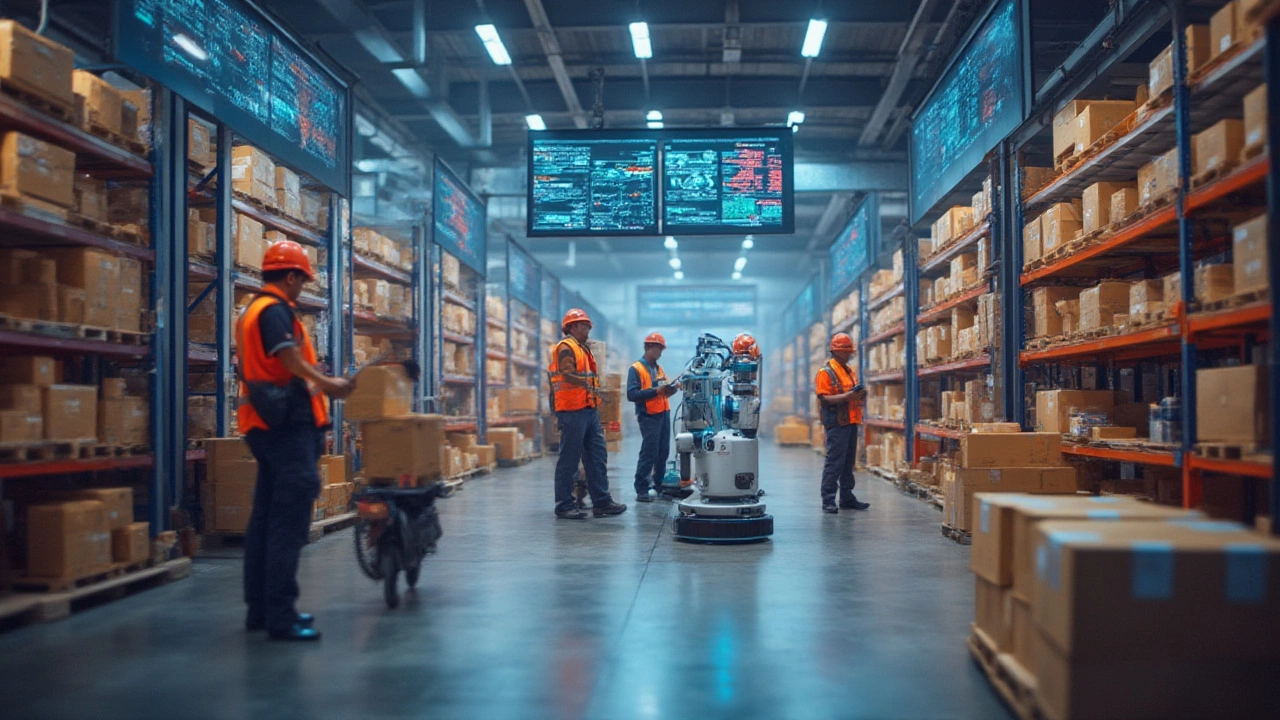E-Logistics Advantages: How Digital Logistics Transforms Delivery, Costs, and Efficiency

Shoppers today expect their orders to arrive fast, tracked every step of the way, and without mistakes. Businesses used to scramble through piles of paperwork and confusing spreadsheets to manage their shipments, but those days are slipping away. E-logistics isn’t just a new trend—it’s a total game-changer. The questions usually aren’t about if you need it, but how quickly you can shift to it before competitors blow right past you. The benefits of e-logistics go far beyond simple speed or having yet another dashboard. Digital tools drive smarter decisions, eliminate endless errors, and save a lot of money. In 2024 alone, supply chain disruptions reportedly cost businesses worldwide over $2 trillion, but companies that adopted e-logistics software saw response times improve by up to 83%. That’s proof this isn’t just fancy talk; it’s real-life savings and rock-solid reliability.
How E-Logistics Streamlines Every Step
If you think e-logistics is only for massive retailers or international brands, think again. The core magic of e-logistics is turning a laundry list of headaches—inventory checks, packing slips, carrier selection, customs forms—into a sleek, almost invisible process. Let’s break down what that looks like in day-to-day operations.
E-logistics platforms connect inventory, warehouse systems, and shipping carriers in real time. That means if one pallet gets pulled from a shelf, the system immediately updates stock levels and even decides whether to split shipments automatically to meet delivery promises. There’s no waiting for a manager to enter data at the end of the day, wildly guessing about what’s left in stock, or sending goods only to discover they’re out of reach. It’s like handing the keys to a warehouse to a super-organized digital manager who never takes a break.
One of the standout features is intelligent routing. Let’s say you’re running a mid-size furniture ecommerce store. A customer in Berlin buys a sofa. Instead of pulling from your main warehouse across Europe, the e-logistics system checks stock at every location and offers the fastest and cheapest shipping solution—often serving up options you wouldn’t have considered by hand. If weather or strikes threaten disruption, the system reroutes on the fly and updates the customer with a new delivery window, all automatically. That not only cuts transit times but also shrinks the carbon footprint and reduces those awkward "Where’s my order?" emails.
Automation isn’t just about speed, either. It banishes human error. Anyone who’s spent hours fixing misprinted labels or re-shipping lost packages knows how quickly small mistakes spiral into lost revenue and unhappy customers. With e-logistics, packing slips, labels, and customs forms generate themselves using correct real-time data, reducing misdeliveries by as much as 56%, according to a study by Capgemini. Plus, tracking info gets sent to customers and internal dashboards instantly, so nobody’s left in the dark.
Let’s not forget about integrations. E-logistics software syncs effortlessly with sales platforms like Shopify, WooCommerce, and in-house ERP systems. Gone are the days of re-entering the same address ten times into different portals. Add in smart analytics and dashboards that highlight bottlenecks, late shipments, or inventory at risk, and businesses get to spot trouble before things get messy. That’s the sort of insight manual systems just can’t provide.
To sum it up: E-logistics lets companies ship more orders, make fewer mistakes, and respond quickly to whatever comes their way. And whether you’re a tiny indie shop or a multinational, the lift in efficiency and accuracy is a real equalizer.
Cost Savings and Better Profit Margins
Let’s talk about the bottom line. When businesses hear "digital transformation," most instantly worry about cost. But e-logistics isn’t just an expense; it’s an investment that pays itself off—sometimes shockingly fast. How? By cutting operational waste, driving down shipping costs, and minimizing errors that bleed money.
Start with workforce costs. Manual logistics usually means teams of staff scrambling to manage orders, track inventory, and fix mistakes. By digitizing these steps, companies often need fewer hands on deck. According to a 2023 study from McKinsey, businesses that adopted e-logistics cut administrative hours by as much as 35%. Staff time freed up can be redirected to growth or customer service instead of fighting fires.
Shipping rates are another pain point. E-logistics platforms use real-time data to pick the cheapest and fastest carrier for every single shipment, even when shipping thousands of orders a week. This can shave off 8% to 15% in transport costs, especially when leveraging dynamic pricing or consolidating shipments in smart ways only automation can handle. You know those horror stories where one late shipment spirals into penalty fees and frantic overtime? E-logistics slashes the frequency of those incidents and keeps partners happier—which brings down overall costs even more.
Inventory holding is a sneaky wallet-drain for lots of companies. The longer stock sits around, the more it costs in terms of warehouse real estate and lost sales if products get dusty and outdated. E-logistics uses real-time analytics to forecast demand, ensuring you stock just enough—no more, no less. Businesses can actually run smaller warehouses or switch to "just-in-time" models and save as much as 27% on storage costs, based on 2024 figures from the Council of Supply Chain Management Professionals (CSCMP).
Returns and misdeliveries are another savings engine. E-logistics reduces return rates through accurate order picking and address verification, so those embarrassing wrong-color or wrong-item shipments become rare. When returns do happen, the system guides them to the right location for swift resale or recycling, minimizing losses. Some systems now include features like digital proof-of-delivery and automated alerts for failed drops, which cut return-related costs by up to 40% in high-volume sectors like apparel and electronics.
On top of all this, better data visibility means smarter contract negotiations with partners. Analytics dashboards show hard numbers on how each carrier performs—delivery speeds, damage rates, successful international claims—which leads to discounts or better contract terms in the next round of talks. Companies that adopt e-logistics aren’t just saving; they’re gaining market flexibility to experiment, optimize, and enjoy fatter margins in an industry famous for tight squeezes.

Better Customer Experience and Transparency
Everyone’s ordered something online and nervously checked the tracking link for days. The average customer wants more transparency than ever, and e-logistics delivers, big time.
One immediate upgrade comes from package tracking. With automated tracking codes sent out as soon as the label prints, customers can watch their shipment move, stop by stop, whether it’s across the city or halfway around the world. This doesn’t just reduce nervous emails or calls asking “Where is it?”—it actively boosts trust. According to PwC’s Global Consumer Insights Pulse Survey 2024, 62% of shoppers said clear delivery visibility made them more likely to stick with a brand for the long haul.
E-logistics also tightens up delivery windows. Rather than vague “3 to 7 days” estimates, customers get real-time predictions, which update along the way if anything changes. If traffic or weather slows things down, the system shoots out a heads-up. That small gesture feels huge from the customer’s perspective, turning a dud experience into a positive one—even when things don’t go perfectly.
Returns are less of a minefield, too. Digital logistics allows customers to trigger returns online and follow clear, step-by-step instructions. The software generates a shipping label and confirms drop-off options based on location, cutting confusion and friction. This sort of streamlined, digital-first process leads to 34% fewer abandoned carts in industries that historically struggle with return hassles, like fashion and lifestyle goods.
But it’s not just about the buyer. B2B companies use e-logistics to pull in clients who demand strict shipment windows and airtight proofs of delivery. Local shops and global suppliers all appreciate that level of accuracy. And staff in-store or at support centers can pull up order statuses, shipping exceptions, or even see where a truck is stuck—empowering them to answer questions confidently and keep business ticking.
Sustainability also comes into play. More shoppers are demanding "green" delivery methods. E-logistics systems can flag eco-friendly carriers or pool orders for fewer delivery miles. Many platforms print a carbon footprint for each shipment, making it easy to reward businesses making responsible choices.
That level of visibility and customization used to be a dream for everyone but industry giants, but cloud-based e-logistics software puts it in reach for businesses of all sizes. And as consumer expectations keep climbing, having these digital tools becomes less of a "nice to have" and more like insurance against losing customers to your savvier competitors.
Scalability and Future-Proofing the Supply Chain
The landscape for shipping and logistics isn’t getting any simpler. Between supply chain shocks from global events, jumps in online ordering, and shifting regulations, flexibility is king. E-logistics gives businesses room to grow without breaking the systems that keep packages moving.
Old-fashioned logistics setups tend to creak whenever sales spike. Holiday season hits, and suddenly staff are drowning in manual entry, errors pile up, and shipments get backed up. E-logistics scales smoothly, whether you’re sending out a dozen boxes or thousands. Need to add a new sales channel, expand to a new region, or start offering same-day delivery? A few clicks can add new carrier integrations or automate extra workflows, rather than launching a months-long IT project.
Consider the surge in "omnichannel" retail—where shoppers buy online, pick up in-store, or expect doorstep delivery, sometimes all in a week. E-logistics platforms handle these different flows effortlessly. No longer do warehouses need separate systems for online and in-store orders. Everything funnels through the same engine, which is why even traditional brick-and-mortar giants are adopting e-logistics like there’s no tomorrow.
Another huge future-proofing bonus is digital compliance and documentation. Whether it’s new VAT rules for shipping into the UK, stricter emissions requirements in European cities, or the US tightening customs on high-value goods—keeping up is daunting. E-logistics platforms automatically update documentation and guide teams through new rules, so shipments aren’t stuck at borders or racking up fines. Businesses stay nimble, even as governments change the playbook overnight.
Security matters too. Older systems were full of risk: lost records, sensitive information exposed in spreadsheets, data scattered between departments. Modern e-logistics employs bank-level encryption and regular backups, shielding businesses from costly data breaches or catastrophic losses if a server fails. Plus, centralization means decision-makers get one version of the truth, not five conflicting spreadsheets.
Analytics and AI are pushing e-logistics to new heights. Predictive algorithms spot everything from peak demand windows to emerging supply chain risks. Some platforms suggest reordering before you even realize you’ll run low, or identify which carrier will deliver to a specific zip code fastest based on past performance. Leaders in e-logistics are now using machine learning to optimize routes not just for cost, but to meet emissions targets or support social causes like local carrier partnerships.
Lastly, flexibility to innovate is priceless. Ten years ago, two-day delivery was revolutionary; now it’s table stakes. In the next few years, drone delivery, autonomous trucks, or new consumer privacy laws may completely change the game again. Companies with e-logistics infrastructure can adapt on the fly—plugging in new technologies or services as needed rather than suffering massive infrastructure reworks. If uncertainty is the new normal, then digital logistics is the closest thing to a "sure bet" businesses can make.
Wrapping it up: E-logistics isn’t about adding another dashboard to your life. It’s about transforming the entire journey—from warehouse shelf to happy customer—into something cheaper, smarter, and ready for anything tomorrow throws your way.